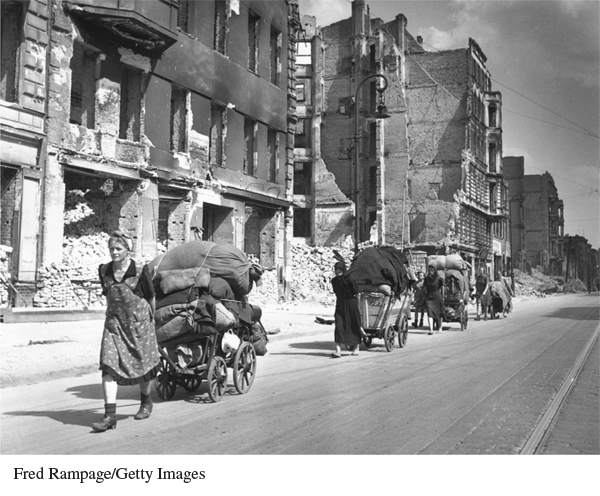The Legacies of the Second World War
In the summer of 1945 Europe lay in ruins. Across the continent, the fighting had destroyed cities and landscapes and obliterated buildings, factories, farms, rail tracks, roads, and bridges. Many cities — including Leningrad, Warsaw, Vienna, Budapest, Rotterdam, and Coventry — were completely devastated. Postwar observers compared the remaining piles of rubble to moonscapes. Surviving cities such as Prague and Paris were left relatively unscathed, mostly by chance.
The human costs of the Second World War are almost incalculable (Map 28.1). The death toll far exceeded the mortality figures for World War I. At least 20 million Soviets, including soldiers and civilians, died in the war. Between 9 and 11 million noncombatants lost their lives in Nazi concentration camps, including approximately 6 million Jews and over 220,000 Sinti and Roma (sometimes called Gypsies). One out of every five Poles died in the war, including 3 million of Poland’s 3.25 million Jews. German deaths numbered 5 million, 2 million of them civilians. France and Britain both lost fewer soldiers than in World War I, but about 350,000 French civilians were killed in the fighting. Over 400,000 U.S. soldiers died in the European and Pacific campaigns, and other nations across Europe and the globe also lost staggering numbers. In total, about 50 million human beings perished in the conflict.

The destruction of war also left tens of millions homeless — 25 million in the U.S.S.R. and 20 million in Germany alone. The wartime policies of Hitler and Stalin had forced some 30 million people from their homes in the hardest-
945
The streets were filled with small, tired caravans of people. . . .
These displaced persons or DPs — their numbers increased by concentration camp survivors and freed prisoners of war, and hundreds of thousands of orphaned children — searched for food and shelter. From 1945 to 1947 the newly established United Nations Relief and Rehabilitation Administration (UNRRA) opened over 760 DP camps and spent $10 billion to house, feed, clothe, and repatriate the refugees.
For DPs, going home was not always the best option. Soviet citizens who had spent time in the West were seen as politically unreliable by political leaders in the U.S.S.R. Many DPs faced prison terms, exile to labor camps in the Siberian gulag, and even execution upon their return to Soviet territories. Jewish DPs faced unique problems. Their families and communities had been destroyed, and persistent anti-
When the fighting stopped, Germany and Austria had been divided into four occupation zones, each governed by one of the Allies — the United States, the Soviet Union, Great Britain, and France. The Soviets collected substantial reparations from their zone in eastern Germany and from former German allies Hungary and Romania. In Soviet-
The authorities in each zone tried to punish those guilty of Nazi atrocities. Across Europe, almost 100,000 Germans and Austrians were convicted of war crimes. Many more were investigated or indicted. In Soviet-
946
In Germany and Austria, occupation authorities set up “denazification” procedures meant to identify and punish former Nazi Party members responsible for the worst crimes and eradicate National Socialist ideology from social and political institutions. At the Nuremberg trials (1945–1946), an international military tribunal organized by the four Allied powers tried the highest-
947
The Nuremberg trials marked the last time the four Allies worked closely together to punish former Nazis. As the Cold War developed and the Soviets and the Western Allies drew increasingly apart, each carried out separate denazification programs in their own zones of occupation. In the Western zones, military courts at first actively prosecuted leading Nazis. But the huge numbers implicated in Nazi crimes, German opposition to the proceedings, and the need for stability in the looming Cold War made thorough denazification impractical. Except for the worst offenders, the Western authorities had quietly shelved denazification by 1948. The process was similar in the Soviet zone. At first, punishment was swift and harsh. About 45,000 former party officials, upper-